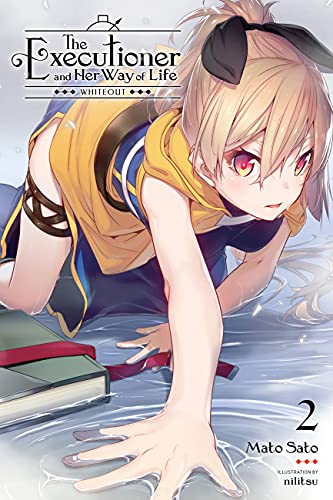By Mato Sato and nilitsu. Released in Japan as “Shokei Shoujo no Virgin Road” by GA Bunko. Released in North America by Yen On. Translated by Jenny McKeon.
The second volume in this series picks up right where the first one left off, with Menou and Akari arriving in the Port City Libelle. Akari is here to have a vacation, Menou is here to try to kill her, and makes an attempt, but it fails as the others have. More worryingly, the terrorist organization we saw on the train in the first book has also got a hook into this city, and it appears to actually have the approval of the royal family – or at least the royal princess, who seems somewhat… detached from life. Menou’s not getting any help from the Church – they loathe her. The fight-loving princess finally meets her, but, unsurprisingly, just wants to fight. And Momo is doing her best to help, but things might be a little more difficult than any of them had assumed. Why is one of the four Human Errors out of her fog prison? Why does she know Akari? Even more chillingly, why does she know Menou?
So, first of all a warning: while this is not quite as bad as, say, Roll Over and Die 4, it is a very gore-filled and violent book. Pandæmonium is our villain here, and she’s a little girl who can essentially resurrect herself from her own body and blood – meaning that she can be killed endlessly and literally crawl out of her dead body. This is, needless to say, disquieting, both as a concept and as prose. She’s a classic type – the killer little girl – but that does not make her any less difficult to deal with. Akari’s own subplot is also rather chilling, as we get a lot more time in the head of the original Akari, the one who is not an airhead (though both are in love with Menou – indeed, that’s pretty much the one trait they share). The revelation from Book 1 is gone into further, and I wonder if a happy ending is truly possible for her – or if death is the only solution.
Not that the world has really had a solution to the isekai’d heroes before. We don’t get much more backstory, and a lot of it is filtered through Pandæmonium, who sees everything in terms of a movie, but it’s pretty clear there’s more going on here than just “the four human errors turned evil and were all destroyed”. For one thing, the one who put them down has also vanished from history… maybe. We get hints here and there as we go through this book that Menou’s past is tied to the human errors more than she’s aware of. (She’s also mostly figured out what Akari is doing, so it’s not simply making her ignorant on purpose.) As with the first book, everything ties back to her mentor Flare, who she gets her nickname (Flarette) from. Good news! They may reunite soon! That is the end of the good news.
Apologies for being somewhat oblique, but this is the sort of book that runs on mysteries, and I’m not ALWAYS a giant spoiler factory. If you’re reading this for the yuri, you may be disappointed – it’s there but isn’t a focus. If you’re reading this for lots of cool action, dark mysteries, and a bit of existential horror… OK, more than a bit… then this should serve you quite well. If you got off the Roll Over and Die train after Book 4 caught up to Japan, pick this up.


I’m about halfway through this and while some of what you warn about seems, at this point, inevitable, I keep wondering if there will – or can – be a payoff that will make it worth it.
I don’t hate this series at all, but I also find it hard to be enthusiastic about it, wondering if it goes anywhere.